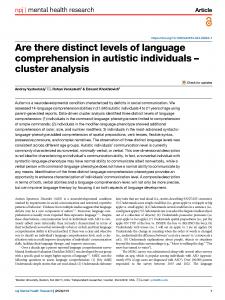A breakthrough discovery of three language comprehension mechanisms in autism
New study discovers three mechanisms of language comprehension paving the way for improving therapy and enhancing outcomes in individuals with language deficits
Philosophy: The traditional definition of language is highly ambiguous. For some philosophers, “language” is equivalent to a “communication system.” Others argue that “language” must be defined more narrowly, in a way that is unique to humans. The results of the new study streamline terminology for describing different language comprehension mechanisms. The ensuing discussion of which language comprehension mechanisms are unique to humans and which are shared with other apes is expected to be most interesting.
Paleoanthropology: The question of when and how archaic humans acquired language is hotly debated. The new empirically-identified language comprehension mechanisms open the door to questions of when each of the three mechanisms was acquired and what evolutionary forces influenced this process.
Linguistics: Mainstream linguistics assumes that grammatical language comprehension is mediated by disjointed mechanisms learned gradually one rule at a time. The alternative generative syntax hypothesis suggests that language comprehension can be simplified into a binary framework, encompassing Merge and non-Merge operations. The findings of the new study show the existence of three separate language comprehension mechanisms, an observation that contradicts current linguistic theories.
Clinical medicine: Language comprehension in children is commonly assessed based on vocabulary. This evaluation method can grossly misrepresent the child’s actual language comprehension progress. Moreover, it encourages therapists to focus on vocabulary training at the expense of exercises that build full language comprehension. The new study provides evidence for creating new assessments evaluating the three mechanisms of language comprehension. These assessments are poised to improve language therapy interventions and enhance outcomes for individuals with language deficits.
Autism: The current practice of characterizing children’s communication ability only in terms of their speech (i.e., verbal, nonverbal, or minimally verbal) is insufficient and one-sided. The new results show that communication abilities can vary independent of verbal abilities. For example, nonverbal children with full syntactic language comprehension have normal ability to communicate albeit nonverbally, while verbal children lacking syntactic language comprehension do not have a normal ability to communicate by any means. The new study demonstrates that the three identified language comprehension mechanisms are neurologically and clinically distinct from the speech ability. A combined two-dimensional language characterization in terms of both language comprehension and verbal level will result in better identification of children’s communication ability and lead to more children reaching their full linguistic potential.
Andrey Vyshdeskiy
Boston University
+1 617-817-1916
vysha@bu.edu
Visit us on social media:
Facebook
LinkedIn
YouTube
TED: The science of imagination - Andrey Vyshedskiy
Legal Disclaimer:
EIN Presswire provides this news content "as is" without warranty of any kind. We do not accept any responsibility or liability for the accuracy, content, images, videos, licenses, completeness, legality, or reliability of the information contained in this article. If you have any complaints or copyright issues related to this article, kindly contact the author above.

